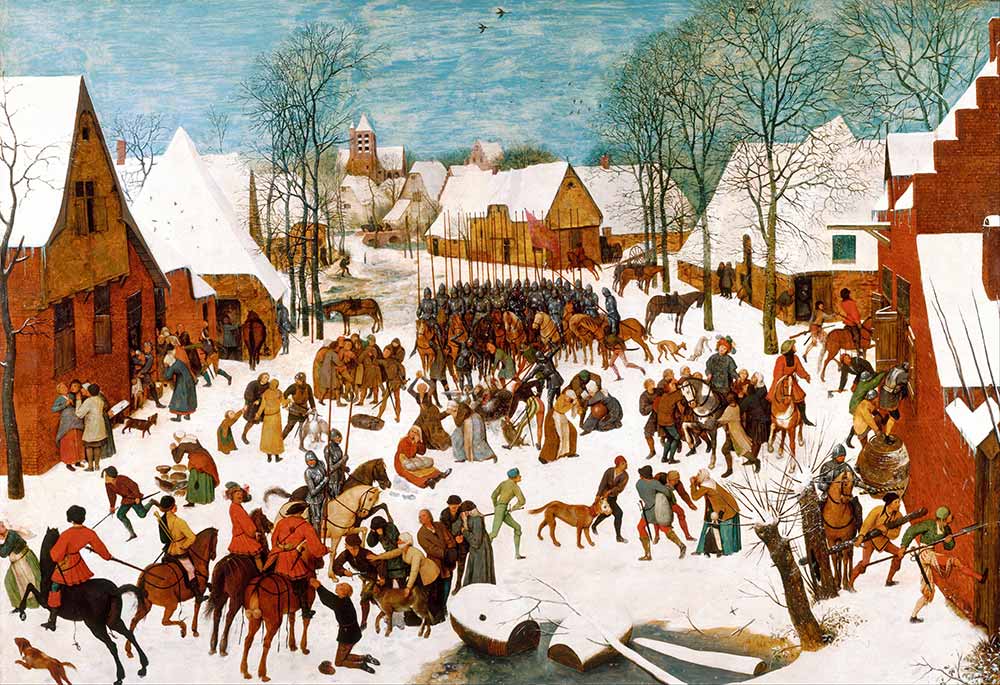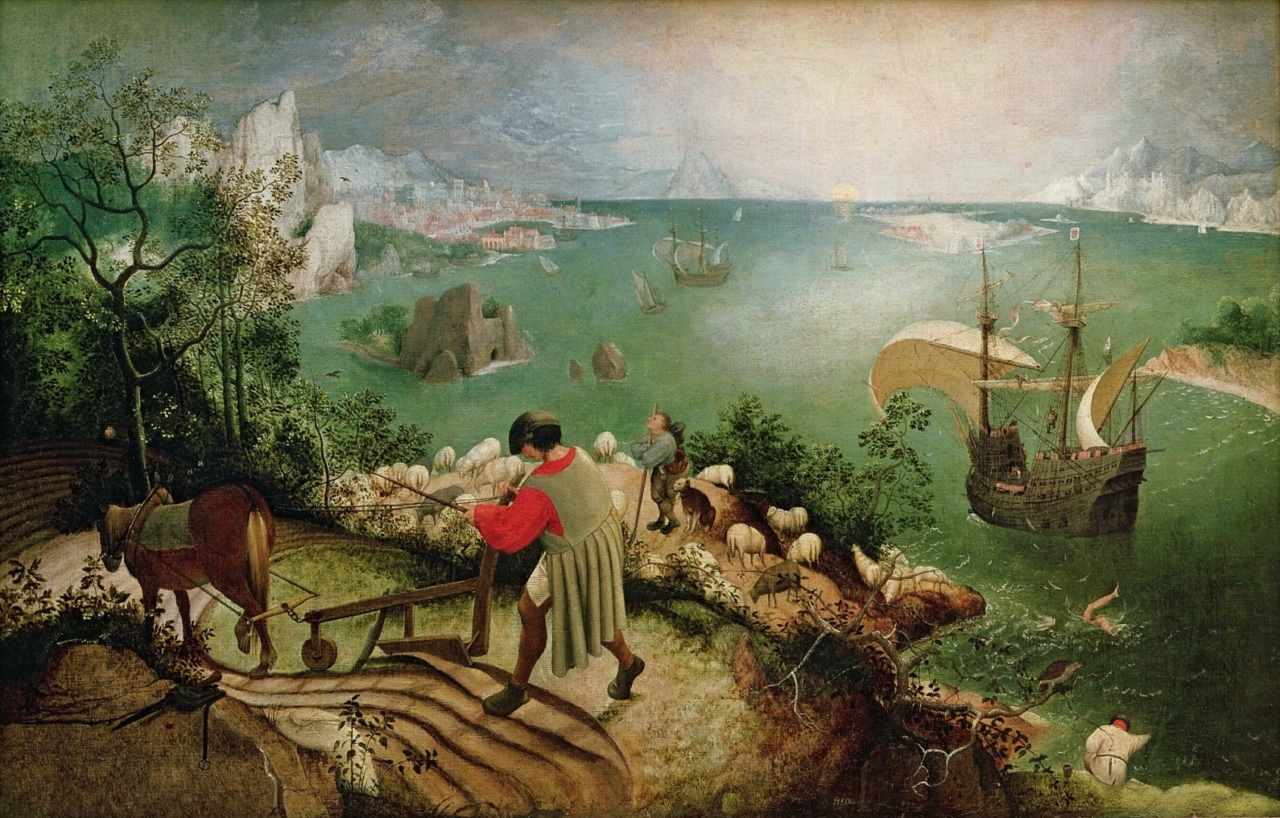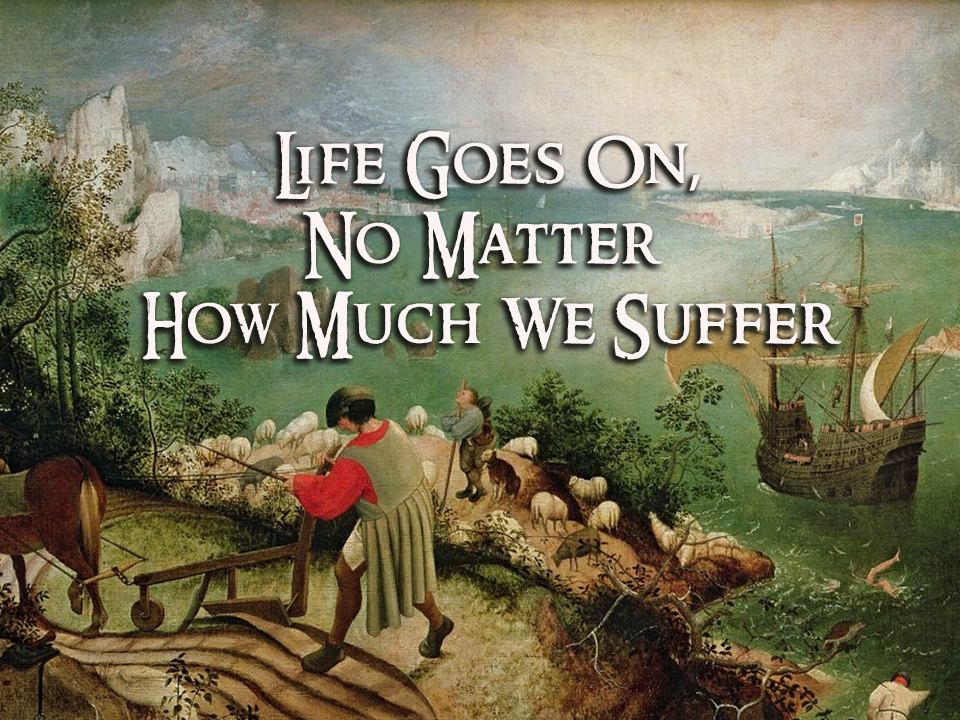MUSEE DES BEAUX ARTS
W. H. Auden
About suffering they were never wrong,
The old Masters: how well they understood
Its human position: how it takes place
While someone else is eating or opening a window or just walking dully along;
How, when the aged are reverently, passionately waiting
For the miraculous birth, there always must be
Children who did not specially want it to happen, skating
On a pond at the edge of the wood:
They never forgot
That even the dreadful martyrdom must run its course
Anyhow in a corner, some untidy spot
Where the dogs go on with their doggy life and the torturer’s horse
Scratches its innocent behind on a tree.
In Breughel’s Icarus, for instance: how everything turns away
Quite leisurely from the disaster; the ploughman may
Have heard the splash, the forsaken cry,
But for him it was not an important failure; the sun shone
As it had to on the white legs disappearing into the green
Water, and the expensive delicate ship that must have seen
Something amazing, a boy falling out of the sky,
Had somewhere to get to and sailed calmly on.
About Poem
“Musee des Beaux-Arts” is an ekphrastic poetry, which means the poem informs us of a pictorial representation of artworks. The English translation of the poem’s name means “Museum of Fine Arts.” W. H. Auden wrote this poem after visiting the Royal Museum of Art in Belgium.
W. H. Auden observes some famous paintings by Pieter Bruegel and discusses the indifference to suffering. These are “The Census at Bethlehem,” “The Massacre of the Innocents,” and “Landscape with the Fall of Icarus,” which are referenced directly. Some critics also suggest that “The Winter Landscape with Skates and A Bird Trap” painting may have been mentioned.
The poem starts with an emphasis on suffering. When the poet refers to “old masters,” he means “old artists.” The ancient artists recognized the human condition of suffering. They represented in their paintings one side’s sorrow while the other went on with their lives.
Lines four through eight refer to “The Census at Bethlehem.”
It is depicted just before the birth of Jesus in this painting. Due to Caesar Augustus’ edict that the entire Roman world is taxed in their lineage cities, Joseph and Mary, pregnant with Jesus, leave Nazareth and travel to Bruegel. In the painting’s left corner, some people are opening the window. Some people are eating food. Some are simply walking around in another corner. People are continuing their daily lives regardless of the miracle that will happen. According to the poet, the elderly are eagerly waiting for the birth of Jesus, while children are skating, playing, and unconcerned about the event. The elderly need this miracle because they have already suffered enough, whereas the young have never experienced suffering. They are inexperienced in life.
The dreadful martyrdom refers to “The Massacre of the Innocents”.

After the birth of Jesus, King Herod sees Jesus as a threat to his rule and orders the execution of all infants under the age of two in Bethlehem. These people were known as the first Christian martyrs. The people in the painting are upset because their children have been taken away from them. They are weeping and begging for their boys’ lives, but horses scratch their behinds on a tree, and dogs go about their business. So even the dreadful martyrdom must run its course, and the old artists know about it.
“The Landscape with the Fall of Icarus.”

XIR3675 Landscape with the Fall of Icarus, c.1555 (oil on canvas) by Bruegel, Pieter the Elder (c.1525-69); 73.5×112 cm; Musees Royaux des Beaux-Arts de Belgique, Brussels, Belgium; (add.info.: Icarus seen with his legs thrashing in the sea;); Giraudon; Flemish, out of copyright
In the poem’s second part, there is a direct reference to “The Landscape with the Fall of Icarus.” The painting was inspired by a myth written by Ovid in The Metamorphosis. In order to escape from his captivity in Crete, Daedalus makes wings of bird feathers for himself and his son Icarus. Before they run away, he tells his son to stay in the middle of the sea and the sun; otherwise, the sea may wet the wings, or the sun may melt the wax. While Daedalus and Icarus float in the sky, a fisherman, a shepherd, and a peasant see them, but they think they are gods flying in the sky and don’t care. Having tasted freedom for the first time, Icarus flies dangerously near the sun. The wax melts in the sun, and Icarus falls into the water. When Daedalus sees the feathers of birds floating on the sea, he realizes that his son has fallen into the sea. This is an indescribable pain for Daedalus.
In the drawing, we see a fisherman, a shepherd, and a peasant, and they are drawn in the same way as described in the myth. Thanks to his legs plunging into the green-coloured waters and feathers flying around them, we realize where Icarus is. Next to the legs is a large vessel.
The Indifference of Life: Icarus’ Fall and the Unnoticed Tragedy

In the poem, the disaster refers to the fall of Icarus. Everything turns away from Icarus’ fall. Perhaps the ploughman heard the sound of a splash when Icarus fell into the water or the sound of Daedalus’ scream behind his beloved son, but this was not a significant failure for the ploughman. While Daedalus has lost his son and Icarus has lost his own life, the ploughman continues his daily routine. The sun still shines on Icarus’ legs because the sun has to continue to shine.
There is a personification of the ship, and something amazing refers to, again, Icarus’ fall from the sky. The ship was supposed to have seen the fall of Icarus, which took place very close to the ship, but it had somewhere to go and continued on its way. Everything goes on with their lives, except for Daedalus and Icarus, whether they witnessed the incident or not.
Suffering and Life’s Relentless Continuity
That’s how suffering works. Except for the sufferer, everything goes on as usual. Even Daedalus didn’t stay where he was after Icarus died, he continued his life somehow. Because life must continue. We can interpret that no one pays attention to what is happening as indifference to life and suffering. But can we blame them for moving on with their lives, for doing what they should be doing? Life goes on, no matter how much we suffer. Maybe we are no longer aware of the sun’s presence, but the sun continues to shine on our suffering as it shines on Icarus’ legs. Because it has to.


Yorumunuzu Yayınlayın